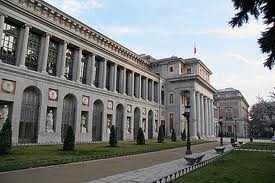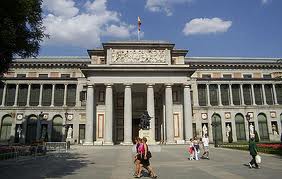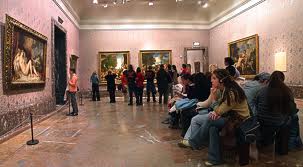Museum El Prado, Madrid

Perhaps the most emblematic institution in the country's art scene is the Museum El Prado, a required stop in every tourist's schedule when they visit Madrid. Equipped with a stock of over 7500 paintings and close to 15000 other works of art, this museum is among the largest in Europe, both in terms of its collection and the amount of visitors it welcomes on a yearly basis.
The main building of the museum is located right in the heart of the capital, between the fountain of Neptune and the central train station of Atocha, along a wide boulevard that bears its name, nicely fitted with a double row of trees that offer solace to the tired traveller.
Villanueva Building
Part of the project of urbanization and regeneration put forward by king Charles III towards the end of the XVIII century, the building that currently serves as home to the museum was originally intended to be devoted to the Royal Cabinet of Natural History. Designed by Juan de Villanueva, one of Charles III's favourite architects, the building was begun in 1785 but it was left unfinished until well into the XIX century.

It was only with the final expulsion of the French in 1814 and the emergence of Ferdinand VII as the new king that the project regained its original vigour. Now on the other end of the great schism that was the French Revolution, the zeal to pursue the sort of rational learning advocated by intellectuals during the time of the Enlightenment soon died out and the project then took the guise of a national gallery.
Within five years the building, used as a garrison and arsenal during the French invasion, was restored, fitted with a new roof and furbished to house a selection of the royal collection of paintings and sculptures. By 1819, the Museum El Prado had been born and the general physiognomy of the city of Madrid had changed forever, turning it into what you would see if you come and learn Spanish in Madrid .
As might be expected, the most remarkable portion of the collection displayed in the Museum El Prado belongs to works of art produced by the great exponents of Spanish art. Naturally, some extraordinary paintings by the great master Diego de Velázquez are there to be seen in the museum on a daily basis, such as the iconic Las Meninas, or the carefully constructed Las Hilanderas, a painting with deep intellectual connotations beneath its apparently simple structure.
A favourite section of the museum among frequenters tends to be the area devoted to Francisco Goya, which includes a whole floor full of his courtly work, included major tapestry designs. It is, however, Goya's more morbid mood, displayed in the sequence of paintings pertaining to the May killings in Madrid, and especially in the frescoes that decorated his own home, commonly known as the 'black paintings', that usually catch most of the public's attention.

Of particular high standing are the collection's examples of El Greco's colourful and troubling art, especially in The Holy Trinity. Similarly, the selection of paintings by José de Ribera and his specific control of the technique of the chiaroscuro in his elaboration of deeply felt scenes of intense Tenebrism cannot fail to cause emotion of visitors.
Indeed, when it comes to the great surprises met by tourists during their passage through the Museum El Prado, high up on the list tends to feature Ribera's Ticio, whose bowels are being eaten eternally by an eagle. Precariously hanging in space, the shape of a falling Ticio generates great anxiety on the viewer, enhanced by its mirroring image on the painting titled Ixion, just across the short hallway.
But apart from an extraordinary collection of spanish masters, the Museum El Prado also boasts a significant number of remarkable paintings by Italian artists and painters from the region of Flanders, both of them historically linked to the Iberian peninsula for many years. Similarly, if you are coming to Madrid you cannot miss the collection of early paintings, which include some masterworks from El Bosco.
